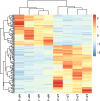Transcriptome analysis of ovary tissues from low- and high-yielding Changshun green-shell laying hens
- PMID: 33990173
- PMCID: PMC8122536
- DOI: 10.1186/s12864-021-07688-x
Transcriptome analysis of ovary tissues from low- and high-yielding Changshun green-shell laying hens
Abstract
Background: Changshun green-shell laying hens are unique to Guizhou Province, China, and have high egg quality. Improving egg production performance has become an important breeding task, and in recent years, the development of high-throughput sequencing technology provides a fast and exact method for genetic selection. Therefore, we aimed to use this technology to analyze the differences between the ovarian mRNA transcriptome of low and high-yield Changshun green-shell layer hens, identify critical pathways and candidate genes involved in controlling the egg production rate, and provide basic data for layer breeding.
Results: The egg production rates of the low egg production group (LP) and the high egg production group (HP) were 68.00 ± 5.56 % and 93.67 ± 7.09 %, with significant differences between the groups (p < 0.01). Moreover, the egg weight, shell thickness, strength and layer weight of the LP were significantly greater than those of the HP (p < 0.05). More than 41 million clean reads per sample were obtained, and more than 90 % of the clean reads were mapped to the Gallus gallus genome. Further analysis identified 142 differentially expressed genes (DEGs), and among them, 55 were upregulated and 87 were downregulated in the ovaries. KEGG pathway enrichment analysis identified 9 significantly enriched pathways, with the neuroactive ligand-receptor interaction pathway being the most enriched. GO enrichment analysis indicated that the GO term transmembrane receptor protein tyrosine kinase activity, and the DEGs identified in this GO term, including PRLR, NRP1, IL15, BANK1, NTRK1, CCK, and HGF may be associated with crucial roles in the regulation of egg production.
Conclusions: The above-mentioned DEGs may be relevant for the molecular breeding of Changshun green-shell laying hens. Moreover, enrichment analysis indicated that the neuroactive ligand-receptor interaction pathway and receptor protein tyrosine kinases may play crucial roles in the regulation of ovarian function and egg production.
Keywords: Changshun green-shell laying hens; Egg production; Ovary; Transcriptome analysis.
Conflict of interest statement
The authors declare that they have no competing interests.
Figures






Similar articles
-
Transcriptome analysis of hypothalamus and pituitary tissues reveals genetic mechanisms associated with high egg production rates in Changshun green-shell laying hens.BMC Genomics. 2023 Dec 20;24(1):792. doi: 10.1186/s12864-023-09895-0. BMC Genomics. 2023. PMID: 38124055 Free PMC article.
-
Ovarian Transcriptome Profile from Egg-Laying Period to Incubation Period of Changshun Green-Shell Laying Hens.Genes (Basel). 2025 Mar 29;16(4):394. doi: 10.3390/genes16040394. Genes (Basel). 2025. PMID: 40282353 Free PMC article.
-
Pituitary transcriptome profile from laying period to incubation period of Changshun green-shell laying hens.BMC Genomics. 2024 Mar 25;25(1):309. doi: 10.1186/s12864-024-10233-1. BMC Genomics. 2024. PMID: 38528494 Free PMC article.
-
Integrating genomics and transcriptomics to identify candidate genes for high-altitude adaptation and egg production in Nixi chicken.Br Poult Sci. 2024 Dec;65(6):652-664. doi: 10.1080/00071668.2024.2367228. Epub 2024 Jun 26. Br Poult Sci. 2024. PMID: 38922310 Review.
-
Interacting Networks of the Hypothalamic-Pituitary-Ovarian Axis Regulate Layer Hens Performance.Genes (Basel). 2023 Jan 4;14(1):141. doi: 10.3390/genes14010141. Genes (Basel). 2023. PMID: 36672882 Free PMC article. Review.
Cited by
-
Intraovarian injection of 3D-MSC-EVs-ECM gel significantly improved rat ovarian function after chemotherapy.Reprod Biol Endocrinol. 2024 Oct 16;22(1):125. doi: 10.1186/s12958-024-01299-3. Reprod Biol Endocrinol. 2024. PMID: 39415205 Free PMC article.
-
The hypothalamic transcriptome reveals the importance of visual perception on the egg production of Wanxi white geese.Front Vet Sci. 2024 Sep 20;11:1449032. doi: 10.3389/fvets.2024.1449032. eCollection 2024. Front Vet Sci. 2024. PMID: 39372898 Free PMC article.
-
Comparative transcriptome analysis of Indian domestic duck reveals candidate genes associated with egg production.Sci Rep. 2022 Jun 29;12(1):10943. doi: 10.1038/s41598-022-15099-5. Sci Rep. 2022. PMID: 35768515 Free PMC article.
-
Proteomic analysis of egg production peak and senescence in the ovaries of Taihe black-boned silky fowl (Gallus gallus domesticus Brisson).BMC Genomics. 2025 Jan 7;26(1):17. doi: 10.1186/s12864-024-11180-7. BMC Genomics. 2025. PMID: 39773120 Free PMC article.
-
Long noncoding RNA network for lncRNA-mRNA interactions throughout swine estrous cycle reveals developmental and hormonal regulations in reproductive tissues.J Anim Sci Technol. 2024 Nov;66(6):1109-1126. doi: 10.5187/jast.2023.e137. Epub 2024 Nov 30. J Anim Sci Technol. 2024. PMID: 39691614 Free PMC article.
References
-
- Zaheer K. An updated review of chicken eggs: production, consumption, management aspects, and nutritional benefits to human health. Food Nutr Sci. 2015;66(13):1208–20.
MeSH terms
Grants and funding
LinkOut - more resources
Full Text Sources
Other Literature Sources
Research Materials
Miscellaneous

